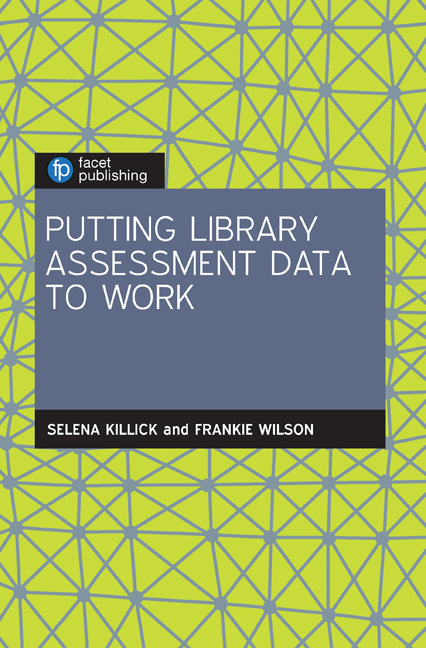Book contents
- Frontmatter
- Dedication
- Contents
- List of figures and tables
- List of case studies
- Authors and contributors
- Acknowledgements
- 1 Introduction to Library Assessment
- 2 Institutional Measures of Student Satisfaction
- 3 Standardised Library Surveys
- 4 In-House Library Surveys
- 5 Library Statistics
- 6 Qualitative Feedback
- 7 Emerging Techniques
- 8 More than Measuring: using Assessment Holistically
- 9 Conclusions
- Index
8 - More than Measuring: using Assessment Holistically
Published online by Cambridge University Press: 02 October 2019
- Frontmatter
- Dedication
- Contents
- List of figures and tables
- List of case studies
- Authors and contributors
- Acknowledgements
- 1 Introduction to Library Assessment
- 2 Institutional Measures of Student Satisfaction
- 3 Standardised Library Surveys
- 4 In-House Library Surveys
- 5 Library Statistics
- 6 Qualitative Feedback
- 7 Emerging Techniques
- 8 More than Measuring: using Assessment Holistically
- 9 Conclusions
- Index
Summary
Chapter overview
In this final substantive chapter we turn our attention to ways of using the results of assessment activities, in particular the power of taking a holistic approach to library assessment.
As described in Chapter 1, what makes library assessment different from performance measures and indicators is that the information gathered and/or results of analysis are used to drive change or communicate with stakeholders. The assessment activities presented in previous chapters are powerful forces for service improvement in their own right, but bringing the outputs together enables library staff to acquire a deeper understanding of users’ needs and the impact of service changes, and to tell the story of the library service or customer experience as a whole.
In this chapter we discuss how the method of presenting the results of assessment activities is as important as the results themselves. We present case studies where data sets have been successfully combined to generate deeper understanding, and where the results of assessment activities have been used to advocate successfully on behalf of the library service.
The following case studies are presented in this chapter:
• Case Study 8.1 Departmental reporting at the University of York (Vanya Gallimore, University of York)
• Case Study 8.2 University Library Services Sunderland: articulating value and impact through visual presentation of combined data sets (Kay Grieves, University Library Services Sunderland).
Both the University of York and University of Sunderland library services took as their starting point the needs of a particular target group. Both planned data collection to evidence whether the library service was successful in meeting these needs – in Sunderland's case designing new, appropriate collection methods, whereas York identified existing sources of data and feedback. Through focusing on a holistic approach, using all appropriate sources of information, staff in each of the library services gained insights into how to improve the support they offer to the specific group. They were then able to demonstrate the impact of making such improvements, so completing the iterative plan–do–check–adjust cycle of continuous improvement (Deming, 2000).
The University of York Library Service produces a highly visual presentation of a report covering three areas: a summary of the past year, the impact of the previous year's actions, and proposed actions for the coming year.
- Type
- Chapter
- Information
- Putting Library Assessment Data to Work , pp. 145 - 162Publisher: FacetPrint publication year: 2019



